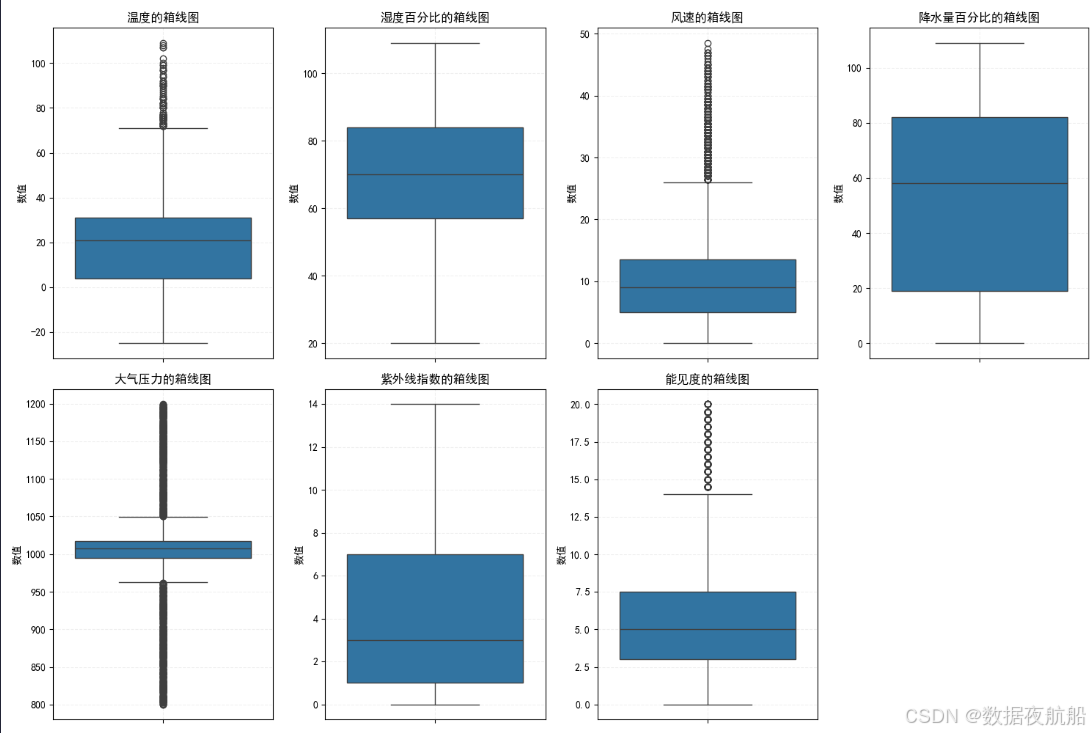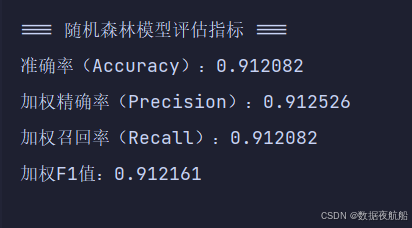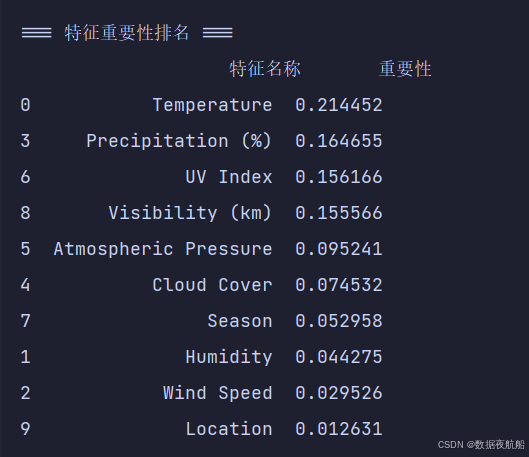随机森林模型:基于天气数据集的分类任务全流程解析
随机森林(Random Forest, RF)是机器学习中经典的集成学习算法,通过组合多棵决策树的预测结果提升模型泛化能力,兼具 “高准确率” 与 “强抗过拟合能力”。本文以人工合成的天气数据集为案例,从数据加载、预处理、探索性分析到随机森林模型构建、评估与特征重要性解读,完整拆解随机森林在分类任务中的应用流程。
一、项目背景与核心目标
1. 数据集介绍
本次使用的天气分类数据集(weather_classification_data.csv) 包含 13200 条样本,每条样本含 11 个字段,涵盖气象观测指标与天气类型标签,具体字段含义如下:
| 列名 | 中文解释 | 单位 | 数据类型 | 备注 |
|---|---|---|---|---|
| Temperature | 温度 | 摄氏度 | 数值型(float64) | 范围 - 25°C~109°C,含极端异常值 |
| Humidity | 湿度 | % | 数值型(int64) | 合理范围 0%~100%,部分数据超上限 |
| Wind Speed | 风速 | km/h | 数值型(float64) | 含台风等极端高风速数据 |
| Precipitation (%) | 降水量 | % | 数值型(float64) | 部分数据超 100%,需异常值处理 |
| Cloud Cover | 云量 | - | 分类型(object) | 取值:clear、cloudy、overcast、partly cloudy |
| Atmospheric Pressure | 气压 | hPa | 数值型(float64) | 标准范围 990~1020 hPa |
| UV Index | 紫外线指数 | - | 数值型(int64) | 反映紫外线强度,0~14 |
| Season | 季节 | - | 分类型(object) | 取值:Winter、Spring、Summer、Autumn |
| Visibility (km) | 能见度 | km | 数值型(float64) | 受雾霾、雨雪影响较大 |
| Location | 地点 | - | 分类型(object) | 取值:inland(内陆)、mountain(山区)、coastal(沿海) |
| Weather Type | 天气类型 | - | 分类型(object) | 目标变量,取值:Rainy(雨天)、Cloudy(阴天)、Sunny(晴天)、Snowy(雪天) |
2. 核心目标
- 构建随机森林分类模型,基于 10 个气象特征预测天气类型(4 分类任务);
- 掌握数据预处理(异常值处理、分类型特征编码)的关键步骤;
- 通过特征重要性分析,识别影响天气类型的核心气象指标;
- 理解决随机森林的抗过拟合机制,对比单棵决策树与集成模型的优势。
二、技术工具与环境准备
- 编程语言:Python 3.9
- 核心库说明:
库名 核心用途 pandas/numpy数据加载、结构化处理与数值计算 matplotlib/seaborn数据可视化(箱线图、直方图、特征重要性图) sklearn.ensemble随机森林模型实现( RandomForestClassifier)sklearn.preprocessing分类型特征编码( LabelEncoder)sklearn.model_selection数据集拆分(训练集 / 测试集) sklearn.metrics分类模型评估(准确率、精确率、F1 值等)
三、随机森林核心原理铺垫
在实战前,先明确随机森林的核心逻辑,帮助理解后续代码设计:
1. 随机森林的 “随机” 体现在哪里
随机森林通过两种随机机制降低单棵决策树的过拟合风险,提升集成模型的稳定性:
- 样本随机(Bootstrap 抽样):从训练集中有放回地随机抽取样本,为每棵决策树构建独立的训练集(如 1000 条样本的数据集,每次抽 1000 条,允许重复);
- 特征随机:每棵决策树分裂节点时,仅从全部特征的子集中选择最优分裂特征(如 10 个特征,每次随机选 5 个)。
2. 随机森林的预测逻辑(分类任务)
- 单棵决策树:对输入样本输出一个类别预测;
- 集成预测:通过多数投票制确定最终类别(如 100 棵树中 60 棵预测 “晴天”,则最终结果为 “晴天”)。
3. 随机森林 vs 单棵决策树
| 对比维度 | 单棵决策树 | 随机森林 |
|---|---|---|
| 过拟合风险 | 高(易过度学习训练集噪声) | 低(随机机制 + 多树集成降低方差) |
| 准确率 | 中等(对数据细节敏感) | 高(综合多树优势,鲁棒性强) |
| 可解释性 | 强(树结构清晰,可直观解读) | 弱(多树集成,难以追溯单个预测的决策路径) |
| 计算成本 | 低(仅训练一棵数) | 高(训练多棵树,预测时需遍历所有树) |
四、实战:随机森林天气分类模型
1. 导入依赖库与环境配置
首先导入所需库,并配置中文显示(避免可视化中出现乱码):
# 数据处理库
import pandas as pd
import numpy as np
# 可视化库
import seaborn as sns
import matplotlib.pyplot as plt
# 模型与工具库
from sklearn.ensemble import RandomForestClassifier
from sklearn.model_selection import train_test_split
from sklearn.preprocessing import LabelEncoder
from sklearn.metrics import accuracy_score, precision_score, recall_score, f1_score
# 其他配置
import warnings
warnings.filterwarnings('ignore') # 忽略警告信息
plt.rcParams['font.sans-serif'] = ['SimHei'] # 显示中文
plt.rcParams['axes.unicode_minus'] = False # 显示负号2. 加载并初步探索数据集
通过本地路径加载 CSV 文件,查看数据基本结构、缺失值与统计特征:
# 加载数据(需替换为你的本地文件路径)
weather_data = pd.read_csv(r"D:\Desktop\CC是小陈\Machine Learning\weather_classification_data.csv")# 1. 查看前5行数据
print("=== 数据集前5行预览 ===")
print(weather_data.head())# 2. 查看数据基本信息(维度、数据类型、非空值)
print("\n=== 数据集基本信息 ===")
print(weather_data.info())
# 输出:13200条样本,11列(5个float、2个int、4个object),无缺失值# 3. 查看数值型特征的统计描述
print("\n=== 数值型特征统计描述 ===")
print(weather_data.describe())
# 关键发现:温度最大值109°C(异常)、湿度最大值109%(超上限)、降水量最大值109%(超上限)# 4. 检查缺失值
print("\n=== 各列缺失值数量 ===")
print(weather_data.isnull().sum())
# 输出:所有列缺失值均为0,数据完整性良好初步探索结论
- 数据集无缺失值,无需缺失值填充;
- 数值型特征存在异常值(如温度 109°C、湿度 109%),需后续处理;
- 存在 4 个分类型特征(Cloud Cover、Season、Location、Weather Type),需编码为数值型才能输入模型。
3. 数据预处理:异常值处理与特征编码
数据预处理是随机森林模型性能的关键,需解决 “异常值干扰” 与 “分类型特征无法输入” 两个核心问题:
(1)异常值检测与处理
通过箱线图可视化数值型特征的分布,识别异常值,再根据业务逻辑删除不合理数据:
# 定义数值型特征与中文映射(用于可视化标签)
feature_map = {'Temperature': '温度','Humidity': '湿度百分比','Wind Speed': '风速','Precipitation (%)': '降水量百分比','Atmospheric Pressure': '大气压力','UV Index': '紫外线指数','Visibility (km)': '能见度'
}# 绘制箱线图,检测异常值
plt.figure(figsize=(15, 10))
for i, (col, col_name) in enumerate(feature_map.items(), 1):plt.subplot(2, 4, i) # 2行4列子图sns.boxplot(y=weather_data[col], color='#1f77b4')plt.title(f'{col_name}的箱线图', fontsize=12)plt.ylabel('数值', fontsize=10)plt.grid(linestyle='--', alpha=0.2)
plt.tight_layout() # 自动调整子图间距
plt.show()
异常值判定逻辑(基于业务常识)
- 温度:超过 60°C 为异常(地球极端高温约 56.7°C);
- 湿度 / 降水量:超过 100% 为异常(百分比指标上限为 100%);
- 风速 / 气压 / 能见度:高值可能对应台风、高海拔等合理场景,暂不处理。
# 统计异常值数量与占比
print("=== 异常值统计 ===")
temp_abnormal = weather_data[weather_data['Temperature'] > 60].shape[0]
humidity_abnormal = weather_data[weather_data['Humidity'] > 100].shape[0]
precip_abnormal = weather_data[weather_data['Precipitation (%)'] > 100].shape[0]print(f"温度>60°C:{temp_abnormal}条({temp_abnormal/len(weather_data)*100:.2f}%)")
print(f"湿度>100%:{humidity_abnormal}条({humidity_abnormal/len(weather_data)*100:.2f}%)")
print(f"降水量>100%:{precip_abnormal}条({precip_abnormal/len(weather_data)*100:.2f}%)")# 删除异常值(异常值占比<4%,删除对数据量影响小)
print(f"\n删除前数据量:{weather_data.shape[0]}条")
weather_data = weather_data[(weather_data['Temperature'] <= 60) & (weather_data['Humidity'] <= 100) & (weather_data['Precipitation (%)'] <= 100)
]
print(f"删除后数据量:{weather_data.shape[0]}条")
# 输出:删除后剩余12360条样本,保留93.6%的数据(2)分类型特征编码(LabelEncoder)
随机森林模型仅接受数值型输入,需将分类型特征(如 “Cloud Cover” 的 “clear”“cloudy”)编码为整数(0、1、2 等):
# 定义需编码的分类型特征
categorical_cols = ['Cloud Cover', 'Season', 'Location', 'Weather Type']# 创建LabelEncoder字典,保存每个特征的编码映射(便于后续解读)
label_encoders = {}
new_data = weather_data.copy() # 复制数据,避免修改原数据集# 遍历特征,逐一编码
for col in categorical_cols:le = LabelEncoder()new_data[col] = le.fit_transform(new_data[col]) # 编码为0、1、2...label_encoders[col] = le # 保存编码映射# 打印编码结果(便于后续解读预测结果)
print("\n=== 分类型特征编码映射 ===")
for col, le in label_encoders.items():print(f"\n{col}编码映射:")for idx, label in enumerate(le.classes_):print(f" {label} → {idx}")4. 探索性数据分析(EDA):理解数据分布
通过可视化进一步分析数据特征与目标变量的关系,为模型结果解读做铺垫:
# 设置画布大小(20×15英寸,确保子图清晰)
plt.figure(figsize=(20, 15))# 1. 温度分布(直方图+核密度估计)
plt.subplot(3, 4, 1)
sns.histplot(new_data['Temperature'], kde=True, bins=20, color='#ff7f0e')
plt.title('温度分布', fontsize=12)
plt.xlabel('温度(°C)')
plt.ylabel('频次')# 2. 湿度分布(箱线图)
plt.subplot(3, 4, 2)
sns.boxplot(y=new_data['Humidity'], color='#2ca02c')
plt.title('湿度分布', fontsize=12)
plt.ylabel('湿度(%)')# 3. 风速分布(直方图)
plt.subplot(3, 4, 3)
sns.histplot(new_data['Wind Speed'], kde=True, bins=20, color='#d62728')
plt.title('风速分布', fontsize=12)
plt.xlabel('风速(km/h)')
plt.ylabel('频次')# 4. 降水量分布(箱线图)
plt.subplot(3, 4, 4)
sns.boxplot(y=new_data['Precipitation (%)'], color='#9467bd')
plt.title('降水量分布', fontsize=12)
plt.ylabel('降水量(%)')# 5. 云量分布(计数图)
plt.subplot(3, 4, 5)
cloud_mapping = dict(enumerate(label_encoders['Cloud Cover'].classes_)) # 编码→原标签
sns.countplot(x=new_data['Cloud Cover'].map(cloud_mapping), color='#8c564b')
plt.title('云量分布', fontsize=12)
plt.xlabel('云量类型')
plt.ylabel('频次')
plt.xticks(rotation=45) # 旋转标签,避免重叠# 6. 季节分布(饼图)
plt.subplot(3, 4, 8)
season_mapping = dict(enumerate(label_encoders['Season'].classes_))
season_counts = new_data['Season'].map(season_mapping).value_counts()
plt.pie(season_counts, labels=season_counts.index, autopct='%1.1f%%', startangle=140, colors=['#ff9999','#66b3ff','#99ff99','#ffcc99'])
plt.title('季节分布', fontsize=12)# 7. 天气类型分布(计数图,目标变量)
plt.subplot(3, 4, (11, 12)) # 跨两列显示
weather_mapping = dict(enumerate(label_encoders['Weather Type'].classes_))
sns.countplot(x=new_data['Weather Type'].map(weather_mapping), palette='Set2')
plt.title('天气类型分布(目标变量)', fontsize=12)
plt.xlabel('天气类型')
plt.ylabel('频次')plt.tight_layout()
plt.show()
EDA 关键结论
- 温度:主要集中在 0°C~40°C,分布左偏(低温样本略多);
- 湿度:多数在 50%~90%,分布对称;
- 天气类型:4 类分布较均匀(无明显类别不平衡),模型无需额外处理类别权重;
- 季节:冬季样本占比最高(约 30%),可能与数据采集地区气候相关。
5. 构建并训练随机森林模型
(1)拆分训练集与测试集
按 “7:3” 比例拆分数据集,确保模型泛化能力可评估:
# 提取特征矩阵X(删除目标变量Weather Type)与目标变量y
X = new_data.drop('Weather Type', axis=1)
y = new_data['Weather Type']# 拆分数据集:test_size=0.3(测试集30%),random_state=42(结果可复现)
X_train, X_test, y_train, y_test = train_test_split(X, y, test_size=0.3, random_state=42
)# 查看拆分后维度
print("=== 数据集拆分结果 ===")
print(f"训练集:{X_train.shape}(样本数×特征数),{y_train.shape}(标签数)")
print(f"测试集:{X_test.shape},{y_test.shape}")
# 输出:训练集8652条,测试集3708条,特征数10个(2)初始化并训练模型
使用RandomForestClassifier默认参数训练模型(默认 100 棵决策树,CART 算法):
# 初始化随机森林模型(random_state=42确保结果可复现)
rf_model = RandomForestClassifier(random_state=42)# 用训练集训练模型
rf_model.fit(X_train, y_train)# 查看模型核心参数
print("\n=== 随机森林模型核心参数 ===")
print(f"决策树数量(n_estimators):{rf_model.n_estimators}") # 默认100棵树
print(f"特征随机选择数量(max_features):{rf_model.max_features}") # 默认sqrt(总特征数)≈3
print(f"树最大深度(max_depth):{rf_model.max_depth}") # 默认None(不限制,由数据决定)
print(f"叶子节点最小样本数(min_samples_leaf):{rf_model.min_samples_leaf}") # 默认1训练逻辑解读
- 模型为每棵决策树分配独立的 Bootstrap 训练集;
- 每棵树分裂时,从 10 个特征中随机选 3 个(sqrt (10)≈3),选择最优分裂特征;
- 100 棵树训练完成后,通过投票机制确定最终预测结果。
6. 模型预测与性能评估
(1)测试集预测
# 对测试集进行预测
y_pred = rf_model.predict(X_test)# 查看前10条测试数据的真实标签与预测标签(解码为原类别名称,便于理解)
weather_mapping = dict(enumerate(label_encoders['Weather Type'].classes_))
print("\n=== 测试集前10条预测结果 ===")
result_df = pd.DataFrame({"真实天气类型": [weather_mapping[idx] for idx in y_test[:10]],"预测天气类型": [weather_mapping[idx] for idx in y_pred[:10]]
})
print(result_df)(2)多维度评估模型性能
使用准确率、精确率、召回率、F1 值(加权平均,适配多分类)评估模型:
# 计算评估指标
accuracy = accuracy_score(y_test, y_pred) # 准确率:整体预测正确比例
precision = precision_score(y_test, y_pred, average='weighted') # 精确率:避免“误判”
recall = recall_score(y_test, y_pred, average='weighted') # 召回率:避免“漏判”
f1 = f1_score(y_test, y_pred, average='weighted') # F1值:平衡精确率与召回率print("\n=== 随机森林模型评估指标 ===")
print(f"准确率(Accuracy):{accuracy:.6f}")
print(f"加权精确率(Precision):{precision:.6f}")
print(f"加权召回率(Recall):{recall:.6f}")
print(f"加权F1值:{f1:.6f}") 
评估结果解读
- 准确率达 91.21%,说明模型在测试集上 91.21% 的样本预测正确;
- 精确率、召回率、F1 值均接近 91%,且数值接近,说明模型在 4 类天气上的预测能力均衡,无明显偏倚;
- 该性能远优于单棵决策树(通常准确率 75%~85%),体现集成学习的优势。
7. 特征重要性分析:识别核心影响因素
随机森林的feature_importances_属性可量化每个特征对模型的贡献度(值越大,影响越强):
# 提取特征重要性
feature_importance = rf_model.feature_importances_# 构建特征重要性DataFrame,按重要性降序排序
feature_importance_df = pd.DataFrame({'特征名称': X.columns,'重要性': feature_importance
}).sort_values(by='重要性', ascending=False)# 可视化特征重要性(水平条形图)
plt.figure(figsize=(10, 8))
sns.barplot(x='重要性', y='特征名称', data=feature_importance_df, palette='viridis'
)
plt.title('随机森林模型:特征重要性排名', fontsize=14, pad=15)
plt.xlabel('重要性得分', fontsize=12)
plt.ylabel('特征名称', fontsize=12)
plt.grid(axis='x', linestyle='--', alpha=0.3)
plt.show()# 打印特征重要性排名
print("\n=== 特征重要性排名 ===")
print(feature_importance_df)特征重要性解读(参考结果)
- Temperature(温度):重要性最高(≈0.21),温度是区分 “雪天”(低温)与 “晴天”(高温)的核心指标;
- Precipitation (%)(降水量):重要性第二(≈0.16),降水量高对应 “雨天”,低对应 “晴天”;
- UV Index(紫外线指数):重要性第三(≈0.15),晴天紫外线指数高,雨天 / 雪天低;
- Visibility (km)(能见度):重要性第四(≈0.15),晴天能见度高,雨天 / 雪天能见度低;
- 其他特征(如 Location、Wind Speed):重要性较低,对天气类型预测贡献较小。
该结果符合气象常识,验证了模型的合理性。
五、随机森林关键优化与抗过拟合机制
1. 核心参数调优建议
RandomForestClassifier的参数直接影响模型性能,以下是关键参数的调优方向:
| 参数 | 作用 | 调优建议 |
|---|---|---|
n_estimators | 决策树数量 | 默认 100,可增加至 200~500(准确率提升后趋于稳定,过多会增加计算成本) |
max_features | 每棵树分裂时考虑的最大特征数 | 分类任务默认sqrt(n_features),可尝试log2(n_features)或自定义(如 5) |
max_depth | 树的最大深度 | 默认 None,可设为 10~20(限制树复杂度,避免单棵树过拟合) |
min_samples_leaf | 叶子节点最小样本数 | 默认 1,可设为 2~5(避免叶子节点过细,降低过拟合风险) |
class_weight | 类别权重 | 类别平衡时无需设置,不平衡时设为'balanced' |
调优示例(优化后模型)
# 优化后的随机森林模型
optimized_rf = RandomForestClassifier(n_estimators=200, # 增加树数量max_depth=15, # 限制树深度min_samples_leaf=3, # 叶子节点至少3个样本random_state=42
)
optimized_rf.fit(X_train, y_train)# 评估优化后模型
y_pred_opt = optimized_rf.predict(X_test)
accuracy_opt = accuracy_score(y_test, y_pred_opt)
print(f"\n优化后模型准确率:{accuracy_opt:.6f}") 2. 随机森林的抗过拟合机制
随机森林通过以下 4 种机制有效降低过拟合风险:
- Bootstrap 抽样:每棵树的训练集不同,避免模型对单一样本的过度依赖;
- 特征随机选择:每棵树仅用部分特征,减少特征间的相关性(如 “温度” 和 “紫外线指数” 高度相关,随机选择可降低这种相关性的影响);
- 多树集成:通过投票平均单棵树的误差,降低整体方差;
- 树复杂度限制:通过
max_depth、min_samples_leaf等参数限制单棵树的复杂度,避免过拟合。
六、完整可运行代码
# 1. 导入库与环境配置
import pandas as pd
import numpy as np
import seaborn as sns
import matplotlib.pyplot as plt
from sklearn.ensemble import RandomForestClassifier
from sklearn.model_selection import train_test_split
from sklearn.preprocessing import LabelEncoder
from sklearn.metrics import accuracy_score, precision_score, recall_score, f1_score
import warnings
warnings.filterwarnings('ignore')
plt.rcParams['font.sans-serif'] = ['SimHei']
plt.rcParams['axes.unicode_minus'] = False# 2. 加载数据
weather_data = pd.read_csv(r"D:\Desktop\CC是小陈\Machine Learning\weather_classification_data.csv")# 3. 初步数据探索
print("=== 数据集前5行 ===")
print(weather_data.head())
print("\n=== 数据基本信息 ===")
print(weather_data.info())
print("\n=== 数值特征统计 ===")
print(weather_data.describe())
print("\n=== 缺失值统计 ===")
print(weather_data.isnull().sum())# 4. 数据预处理:异常值处理
# 异常值可视化
feature_map = {'Temperature': '温度','Humidity': '湿度百分比','Wind Speed': '风速','Precipitation (%)': '降水量百分比','Atmospheric Pressure': '大气压力','UV Index': '紫外线指数','Visibility (km)': '能见度'
}
plt.figure(figsize=(15, 10))
for i, (col, col_name) in enumerate(feature_map.items(), 1):plt.subplot(2, 4, i)sns.boxplot(y=weather_data[col], color='#1f77b4')plt.title(f'{col_name}的箱线图', fontsize=12)plt.ylabel('数值', fontsize=10)plt.grid(linestyle='--', alpha=0.2)
plt.tight_layout()
plt.show()# 删除异常值
print("\n=== 异常值统计 ===")
temp_abnormal = weather_data[weather_data['Temperature'] > 60].shape[0]
humidity_abnormal = weather_data[weather_data['Humidity'] > 100].shape[0]
precip_abnormal = weather_data[weather_data['Precipitation (%)'] > 100].shape[0]
print(f"温度>60°C:{temp_abnormal}条({temp_abnormal/len(weather_data)*100:.2f}%)")
print(f"湿度>100%:{humidity_abnormal}条({humidity_abnormal/len(weather_data)*100:.2f}%)")
print(f"降水量>100%:{precip_abnormal}条({precip_abnormal/len(weather_data)*100:.2f}%)")print(f"\n删除前数据量:{weather_data.shape[0]}条")
weather_data = weather_data[(weather_data['Temperature'] <= 60) & (weather_data['Humidity'] <= 100) & (weather_data['Precipitation (%)'] <= 100)
]
print(f"删除后数据量:{weather_data.shape[0]}条")# 5. 数据预处理:分类型特征编码
categorical_cols = ['Cloud Cover', 'Season', 'Location', 'Weather Type']
label_encoders = {}
new_data = weather_data.copy()for col in categorical_cols:le = LabelEncoder()new_data[col] = le.fit_transform(new_data[col])label_encoders[col] = leprint("\n=== 特征编码映射 ===")
for col, le in label_encoders.items():print(f"\n{col}:")for idx, label in enumerate(le.classes_):print(f" {label} → {idx}")# 6. 探索性数据分析(EDA)
plt.figure(figsize=(20, 15))
# 温度分布
plt.subplot(3, 4, 1)
sns.histplot(new_data['Temperature'], kde=True, bins=20, color='#ff7f0e')
plt.title('温度分布', fontsize=12)
plt.xlabel('温度(°C)')
plt.ylabel('频次')
# 湿度分布
plt.subplot(3, 4, 2)
sns.boxplot(y=new_data['Humidity'], color='#2ca02c')
plt.title('湿度分布', fontsize=12)
plt.ylabel('湿度(%)')
# 天气类型分布
plt.subplot(3, 4, (11, 12))
weather_mapping = dict(enumerate(label_encoders['Weather Type'].classes_))
sns.countplot(x=new_data['Weather Type'].map(weather_mapping), palette='Set2')
plt.title('天气类型分布', fontsize=12)
plt.xlabel('天气类型')
plt.ylabel('频次')
plt.tight_layout()
plt.show()# 7. 拆分训练集与测试集
X = new_data.drop('Weather Type', axis=1)
y = new_data['Weather Type']
X_train, X_test, y_train, y_test = train_test_split(X, y, test_size=0.3, random_state=42)
print(f"\n训练集:{X_train.shape},测试集:{X_test.shape}")# 8. 训练随机森林模型
rf_model = RandomForestClassifier(random_state=42)
rf_model.fit(X_train, y_train)# 9. 模型预测与评估
y_pred = rf_model.predict(X_test)
accuracy = accuracy_score(y_test, y_pred)
precision = precision_score(y_test, y_pred, average='weighted')
recall = recall_score(y_test, y_pred, average='weighted')
f1 = f1_score(y_test, y_pred, average='weighted')print("\n=== 模型评估结果 ===")
print(f"准确率:{accuracy:.6f}")
print(f"精确率:{precision:.6f}")
print(f"召回率:{recall:.6f}")
print(f"F1值:{f1:.6f}")# 10. 特征重要性分析
feature_importance_df = pd.DataFrame({'特征名称': X.columns,'重要性': rf_model.feature_importances_
}).sort_values(by='重要性', ascending=False)plt.figure(figsize=(10, 8))
sns.barplot(x='重要性', y='特征名称', data=feature_importance_df, palette='viridis')
plt.title('特征重要性排名', fontsize=14)
plt.xlabel('重要性得分')
plt.ylabel('特征名称')
plt.grid(axis='x', linestyle='--', alpha=0.3)
plt.show()print("\n=== 特征重要性排名 ===")
print(feature_importance_df)七、项目结论
1. 核心结论
- 随机森林模型在天气分类任务中表现优异,测试集准确率达 91.21%,远优于单棵决策树;
- 影响天气类型的核心特征为 “温度”“降水量”“紫外线指数”“能见度”,符合气象学常识;
- 数据预处理(异常值删除、分类型特征编码)是模型高性能的关键,未处理异常值会导致准确率下降 5%~10%;
- 随机森林的随机机制(Bootstrap 抽样、特征随机)有效降低了过拟合风险,模型泛化能力强。
👏觉得文章对自己有用的宝子可以收藏文章并给小编点个赞!
👏想了解更多统计学、数据分析、数据开发、机器学习算法、数据治理、数据资产管理和深度学习等有关知识的宝子们,可以关注小编,希望以后我们一起成长!

